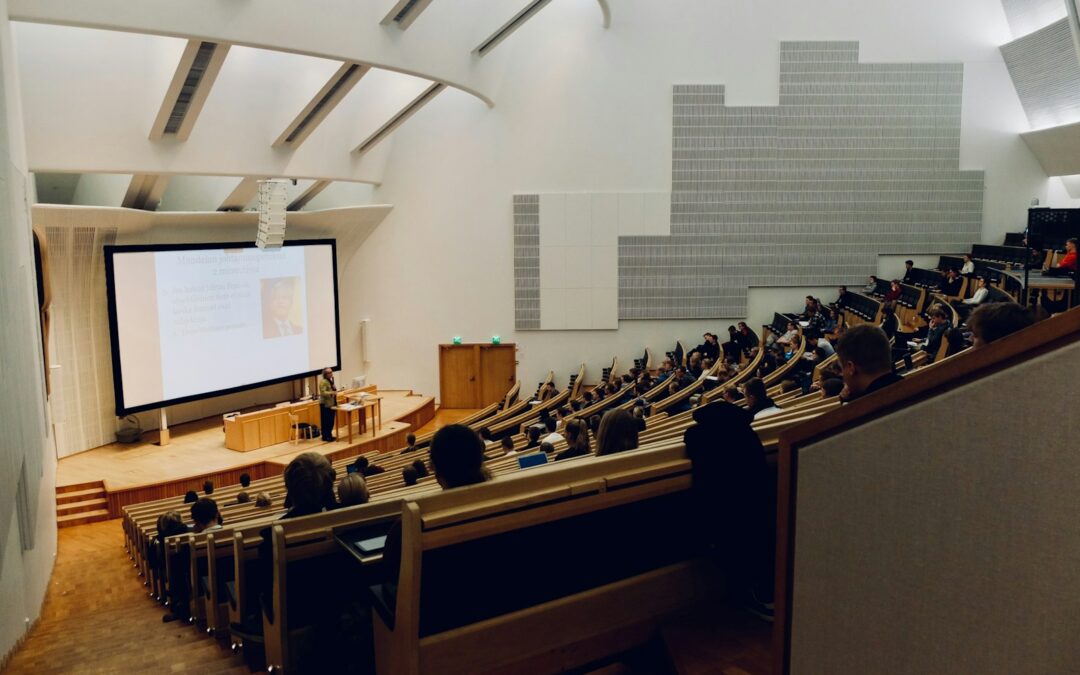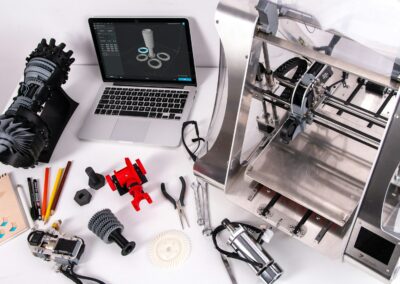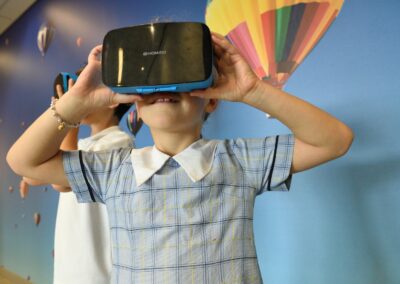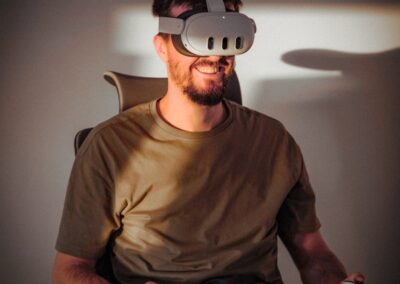Introduction to Virtual Classrooms in K-12 Education
The Rise of Virtual Classrooms
The implementation of virtual classrooms in K-12 education has revolutionized the traditional learning environment, particularly in regions such as Saudi Arabia and the UAE. These virtual platforms leverage advanced technologies, including Artificial Intelligence (AI), The Metaverse, and Generative Artificial Intelligence (GAI), to create interactive and engaging learning experiences. This shift is not merely a response to the challenges posed by global events but a strategic move towards modernizing education and making it more accessible and effective.
Virtual classrooms provide a flexible and scalable solution to educational challenges, offering students the opportunity to learn from anywhere and at any time. This approach not only facilitates uninterrupted learning but also enhances student engagement through interactive tools and personalized learning experiences. As a result, educational institutions in Saudi Arabia and the UAE are increasingly adopting virtual classrooms to complement traditional teaching methods and prepare students for the future.
In addition to improving accessibility, virtual classrooms also support diverse learning styles. By providing various resources, such as video lectures, interactive simulations, and real-time feedback, virtual classrooms cater to the individual needs of students, helping them grasp complex concepts more effectively. This personalized approach to learning is essential for fostering a deep understanding of subjects and enhancing overall academic performance.
Technological Foundations of Virtual Classrooms
The success of virtual classrooms hinges on the seamless integration of cutting-edge technologies. AI plays a pivotal role in creating adaptive learning environments that respond to the needs of each student. By analyzing data on student performance and engagement, AI algorithms can recommend personalized learning paths, ensuring that each student receives the support they need to succeed.
The Metaverse, a virtual reality space where users can interact with a computer-generated environment and other users, offers an immersive learning experience that goes beyond traditional education. In a virtual classroom setting, The Metaverse allows students to engage with interactive 3D models, participate in virtual field trips, and collaborate with peers in a simulated environment. This immersive experience can significantly enhance student engagement and retention of information.
Generative AI further enhances the virtual classroom experience by enabling the creation of customized educational content. Through natural language processing and machine learning, Generative AI can generate interactive quizzes, educational games, and other learning materials tailored to the needs of each student. This technology ensures that learning remains dynamic and engaging, catering to the evolving needs of students.
Implementing Virtual Classrooms in Saudi Arabia and UAE
Saudi Arabia and the UAE have been at the forefront of adopting virtual classrooms in K-12 education. These countries recognize the potential of virtual classrooms to transform education and are investing heavily in the necessary infrastructure and technologies. The implementation process involves several key steps, including selecting the right technology platforms, training teachers, and ensuring access to high-speed internet for all students.
One of the critical factors in the successful implementation of virtual classrooms is the selection of robust and user-friendly technology platforms. Educational institutions in Saudi Arabia and the UAE are partnering with leading technology providers to deploy platforms that offer a wide range of features, including video conferencing, interactive whiteboards, and collaborative tools. These platforms are designed to provide a seamless and engaging learning experience, replicating the dynamics of a physical classroom.
Teacher training is another essential component of successful implementation. Teachers need to be equipped with the skills and knowledge to effectively utilize virtual classroom technologies. This includes training on how to create engaging digital content, manage virtual classrooms, and provide real-time feedback to students. By empowering teachers with the necessary tools and training, educational institutions can ensure that virtual classrooms are used to their full potential.
Impact of Virtual Classrooms on Student Engagement and Learning Outcomes
Enhancing Student Engagement
Virtual classrooms have proven to be highly effective in enhancing student engagement. The use of interactive tools, such as polls, quizzes, and breakout rooms, keeps students actively involved in the learning process. These tools encourage participation and collaboration, making learning more interactive and enjoyable. In Saudi Arabia and the UAE, where education is a top priority, the ability to engage students in this way is crucial for academic success.
Moreover, virtual classrooms provide opportunities for students to interact with peers and teachers in real-time, fostering a sense of community and collaboration. This social aspect of learning is essential for developing critical thinking and problem-solving skills. By participating in group discussions, collaborative projects, and peer reviews, students can learn from each other and gain diverse perspectives on various topics.
The flexibility offered by virtual classrooms also contributes to increased student engagement. Students can access learning materials at their convenience, allowing them to study at their own pace and revisit difficult concepts as needed. This self-paced learning approach helps students stay motivated and engaged, as they can tailor their learning experience to their individual needs and preferences.
Improving Learning Outcomes
The personalized learning experiences offered by virtual classrooms have a significant impact on learning outcomes. AI-driven analytics provide insights into student performance, enabling teachers to identify areas where students may be struggling and provide targeted support. This data-driven approach ensures that each student receives the attention and resources they need to succeed, leading to improved academic performance.
In addition, the interactive and immersive nature of virtual classrooms helps students retain information more effectively. By engaging with 3D models, simulations, and virtual experiments, students can gain a deeper understanding of complex concepts. This hands-on approach to learning is particularly beneficial for subjects such as science, technology, engineering, and mathematics (STEM), where practical application of knowledge is essential.
Virtual classrooms also provide opportunities for formative assessment, allowing teachers to monitor student progress continuously. Through regular quizzes, assignments, and interactive activities, teachers can assess student understanding and provide timely feedback. This continuous assessment helps identify learning gaps early on and allows for prompt intervention, ensuring that students stay on track and achieve their learning goals.
Case Studies of Virtual Classroom Success
Several success stories from Saudi Arabia and the UAE highlight the positive impact of virtual classrooms on student engagement and learning outcomes. In Riyadh, a leading international school implemented a virtual classroom platform that integrates AI and VR technologies. The school reported a significant increase in student participation and academic performance, particularly in STEM subjects. Students were able to conduct virtual experiments, participate in interactive simulations, and collaborate with peers from around the world, enhancing their learning experience.
Similarly, in Dubai, a prominent educational institution adopted a virtual classroom solution to continue delivering high-quality education during the COVID-19 pandemic. The institution utilized Generative AI to create personalized learning materials and provide real-time feedback to students. As a result, student engagement remained high, and the institution reported improved learning outcomes, with students achieving higher grades and demonstrating a better understanding of the curriculum.
These case studies demonstrate the transformative potential of virtual classrooms in K-12 education. By leveraging advanced technologies and innovative teaching methods, educational institutions in Saudi Arabia and the UAE can provide students with engaging and effective learning experiences, preparing them for success in the modern world.
Conclusion
Virtual classrooms represent a significant advancement in K-12 education, offering numerous benefits for student engagement and learning outcomes. In regions like Saudi Arabia and the UAE, where education is a top priority, virtual classrooms can play a crucial role in transforming the educational landscape. By integrating advanced technologies such as AI, The Metaverse, and Generative AI, educational institutions can create interactive and personalized learning experiences that cater to the diverse needs of students.
The success stories from Riyadh and Dubai highlight the positive impact of virtual classrooms on student engagement and academic performance. By providing flexible and accessible learning solutions, virtual classrooms can help bridge the gap between traditional and modern education, ensuring that all students have the opportunity to succeed. As technology continues to evolve, the potential of virtual classrooms will only increase, offering new and exciting possibilities for education in Saudi Arabia, the UAE, and beyond.
—
#VirtualClassroom #K12Education #StudentEngagement #LearningOutcomes #SaudiArabia #UAE #Riyadh #Dubai #ArtificialIntelligence #Blockchain #Metaverse #ExecutiveCoaching #GenerativeAI #ModernTechnology #BusinessSuccess #LeadershipSkills #ManagementSkills #ProjectManagement























